Did you know that there are white fluffy birds that roam the skies and waters of our world? These birds, with their stunning white plumage and soft, fluffy appearance, capture the attention and admiration of people everywhere.
From the majestic snowy owl to the graceful great egret, these birds come in different species and can be found in various regions, from the Arctic to tropical oceans.
But there’s more to these white fluffy birds than meets the eye. Curious to learn about their fascinating behaviors and unique adaptations? Stay tuned as we explore the captivating world of these enchanting creatures.
White Hawk
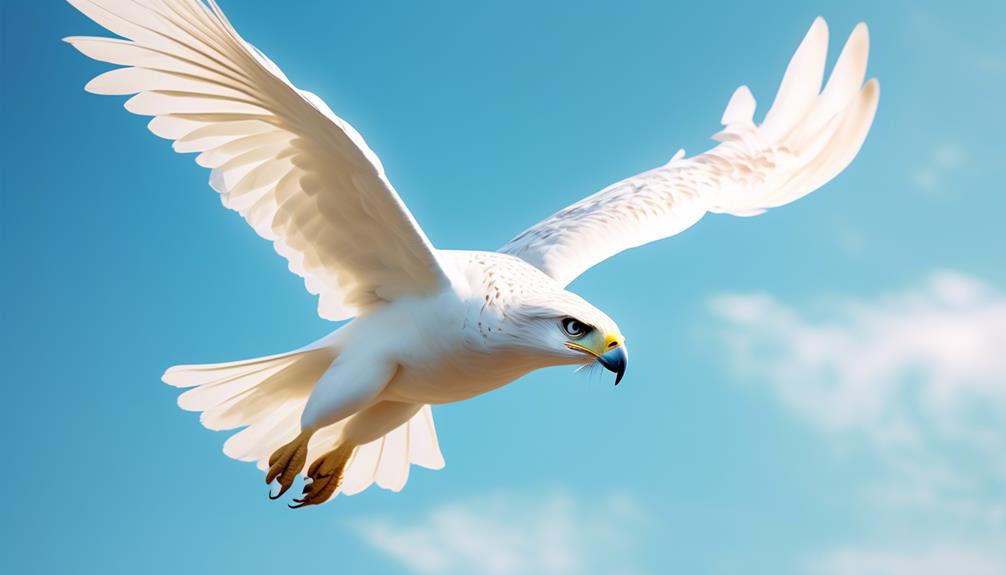
The White Hawk, with its striking white plumage and powerful predatory nature, stands out as a captivating species in the world of birds. Unlike other white birds such as the Snowy Egret, Great Egret, American White Pelican, Great White Heron, Great White Egret, Cattle Egret, Little Egret, and Common Egret, the White Hawk exhibits a unique combination of elegance and ferocity. Its pure white feathers, complemented by black wing tips and tail feathers, create a stunning contrast that’s hard to miss.
Females of the White Hawk species are larger and heavier than males, displaying sexual dimorphism. This size difference adds to their majestic presence in the sky. With four subspecies, the Southern Mexico white hawk boasts the purest white plumage among them all.
But it’s not just their appearance that makes White Hawks captivating. These birds are skilled hunters, preying on various small mammals, reptiles, and birds. Their powerful talons and keen eyesight make them formidable predators in their natural habitat.
Ivory Gull
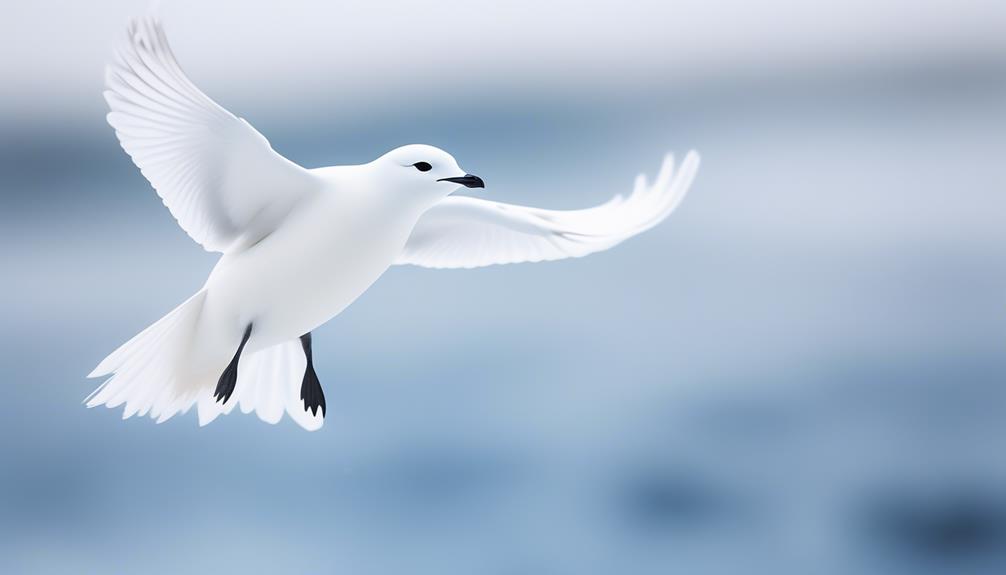
With its almost entirely white plumage, gray beak, and black legs, the Ivory Gull is a striking bird found in the Canadian Arctic, Greenland, and Iceland. This white bird, known as the Ivory Gull, is similar in size and shape to a pigeon, with a wingspan ranging from 42.5 to 47.2 inches. It’s often seen in snowy environments, making it a snowy bird. Unlike other white birds such as the Egret, Great Egret, American White Ibis, Snowy Egret, Wood Stork, and Fairy Tern, the Ivory Gull is adapted to the harsh arctic conditions.
This snowy bird isn’t limited to a single region and has a range that includes Greenland and North America. Weighing between 15.8 to 24.2 ounces and measuring 15.8 to 16.9 inches in length, the Ivory Gull is a remarkable sight in its pristine white plumage. Its gray beak and black legs provide a striking contrast against the snow, allowing it to blend in with its surroundings.
The Ivory Gull’s ability to thrive in such extreme conditions is a testament to its adaptability and resilience. Despite the challenges of its environment, this white bird continues to soar through the Arctic skies, adding to the beauty of the snowy landscapes it calls home.
Snowy Owl
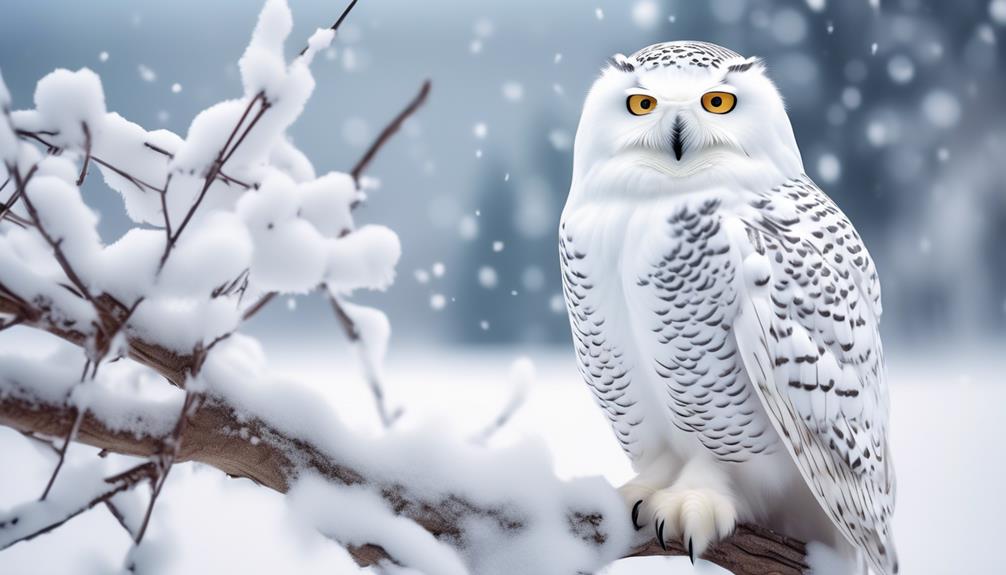
Snowy Owls, with their distinctive black markings on white plumage, are easily recognizable birds found in the Arctic regions of North America and the Palearctic. These beautiful birds have long necks and a sharp black bill. Their feathers are mostly white, but they also have dark feathers that help them blend into their surroundings. Snowy Owls are well adapted to their cold habitat, with their dense plumage and heavily feathered feet providing insulation.
Despite their stunning appearance, Snowy Owls face numerous challenges. Habitat loss, particularly due to climate change, is a major threat to their population. As their Arctic habitat continues to warm, their prey species, such as lemmings, may decline, making it harder for them to find food. Additionally, human disturbances, such as oil and gas development, can disrupt their nesting sites and disturb their natural behaviors.
Conservation efforts are crucial to ensure the survival of Snowy Owls. By protecting their habitat and implementing measures to reduce human disturbance, we can help preserve these magnificent birds for future generations. It’s important to remember that every action we take can have an impact on the fragile ecosystems that Snowy Owls depend on.
Let’s work together to protect these remarkable creatures and ensure their continued presence in the Arctic regions of North America and the Palearctic.
Great Egret
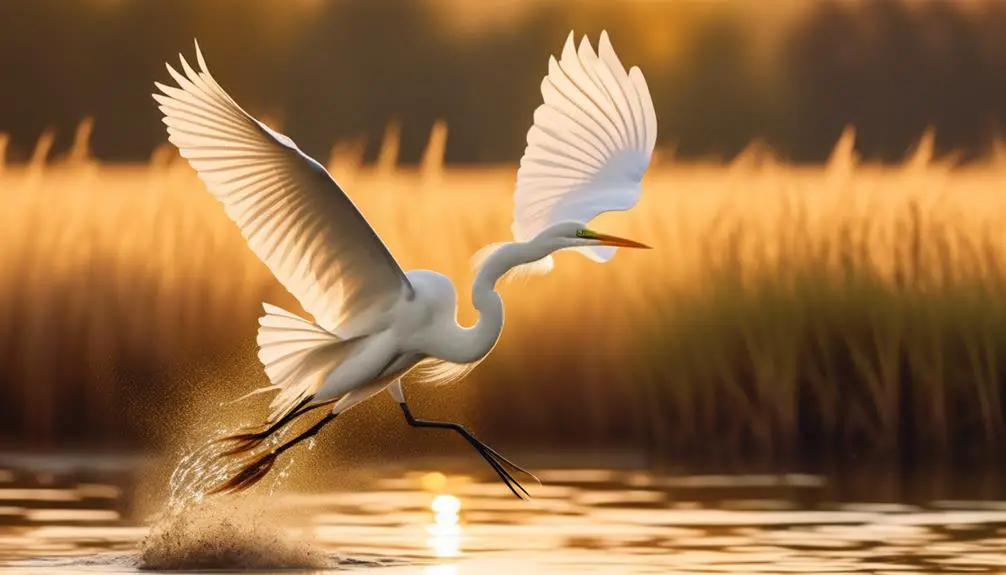
Great Egrets, tall and elegant wading birds, are known for their long legs, white plumage, and distinctive S-curved necks. These beautiful white birds can be found in both freshwater and saltwater wetlands. With their sleek black bills and long legs, they’re perfectly adapted for their aquatic lifestyle.
Great Egrets are skilled hunters, using their long necks and bills to catch their prey. They primarily feed on fish, crustaceans, amphibians, and small mammals. You can often see them standing still in the water, patiently waiting for the perfect moment to strike.
When it comes to nesting, Great Egrets prefer to build their nests high up in trees, forming colonies with other bird species. This nesting strategy provides protection from predators and helps to ensure the survival of their young.
If you ever have the chance to observe a Great Egret up close, you’ll be amazed by their grace and beauty. Their long legs allow them to wade through shallow waters with ease, while their white plumage makes them stand out against the greenery of their surroundings.
Next time you encounter a white bird with long legs and a black bill, take a moment to appreciate the majestic Great Egret and its unique characteristics.
American White Pelican
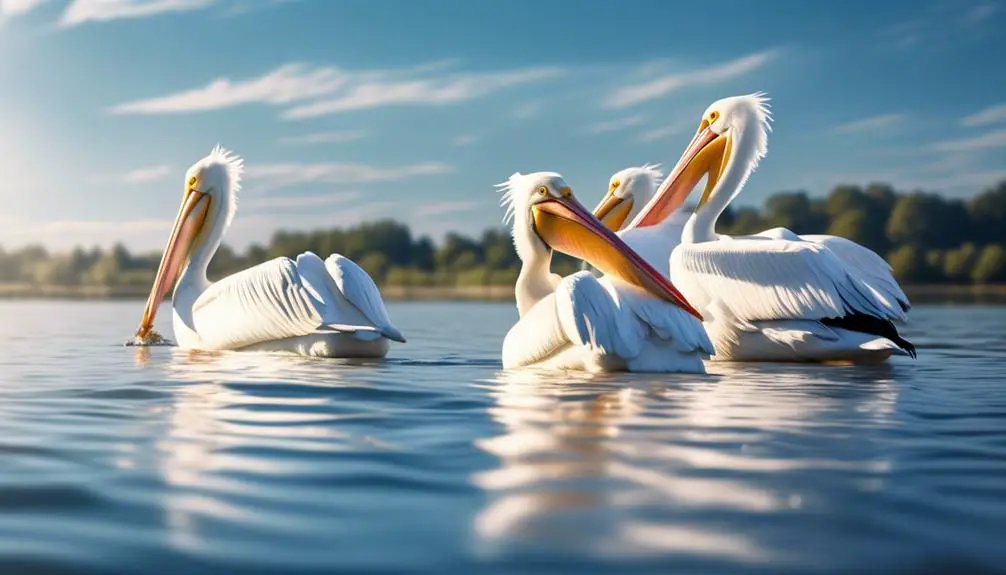
American White Pelicans are large birds known for their predominantly white plumage and distinctive yellow beak. With their impressive wingspan of up to 120 inches, they’re one of the largest birds in North America. These social birds can often be found in nesting colonies near freshwater lakes, prairies, and marshes. American White Pelicans are skilled at cooperative feeding, working together to corral fish into shallow water for easy catching.
During the breeding season, adult pelicans develop a prominent bump on their upper bill known as a ‘horn’. This distinctive feature sets them apart from other white birds, such as egrets and Snowy Birds. Unlike these other birds, American White Pelicans have long legs which are used for wading in shallow water. Their white plumage helps them blend in with their surroundings, making them excellent hunters.
These pelicans are fascinating creatures to observe. Next time you spot a white bird near a body of water, take a closer look. It might just be one of the majestic American White Pelicans.
Masked Booby
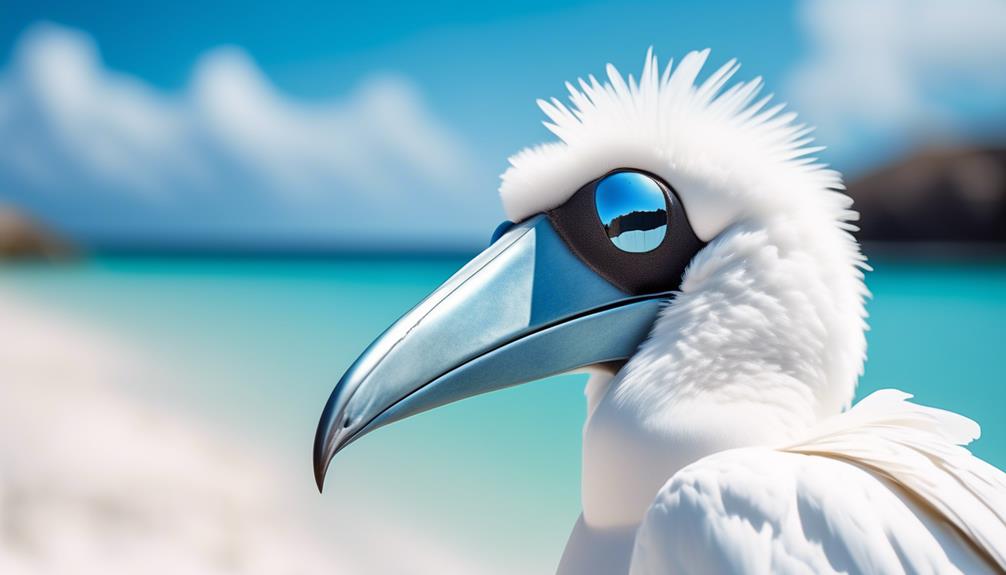
When observing a body of water, keep an eye out for the Masked Booby, a remarkable bird known for its black plumage on the wings and tail feathers contrasting with its white body. These large birds, with an impressive wingspan of up to 67 inches, are a sight to behold. Juvenile Masked Boobies display a striking half black and half white plumage, gradually transitioning to mostly white as they reach adulthood.
Masked Boobies are skilled divers and fishermen, using their exceptional diving abilities to plunge into the ocean from great heights in pursuit of their prey. Found in tropical and subtropical regions, these birds nest in colonies on remote islands and atolls.
As you observe the Masked Booby, you may notice its long bill, which is yellow in color. The bird’s legs are black, and its wingtips are also black, adding to its striking appearance. Its white feathers, with the black plumage featured at the top, create a captivating contrast.
In their natural habitat, you might spot Masked Boobies alongside other wading birds such as Great Egrets and American White Ibises. They can often be found in shallow waters, where they use their long bills to catch fish and other marine organisms.
The Masked Booby is truly a magnificent bird, showcasing a unique combination of black and white plumage, exceptional diving skills, and a captivating presence in its tropical and subtropical habitats.
Phillippine Cockatoo
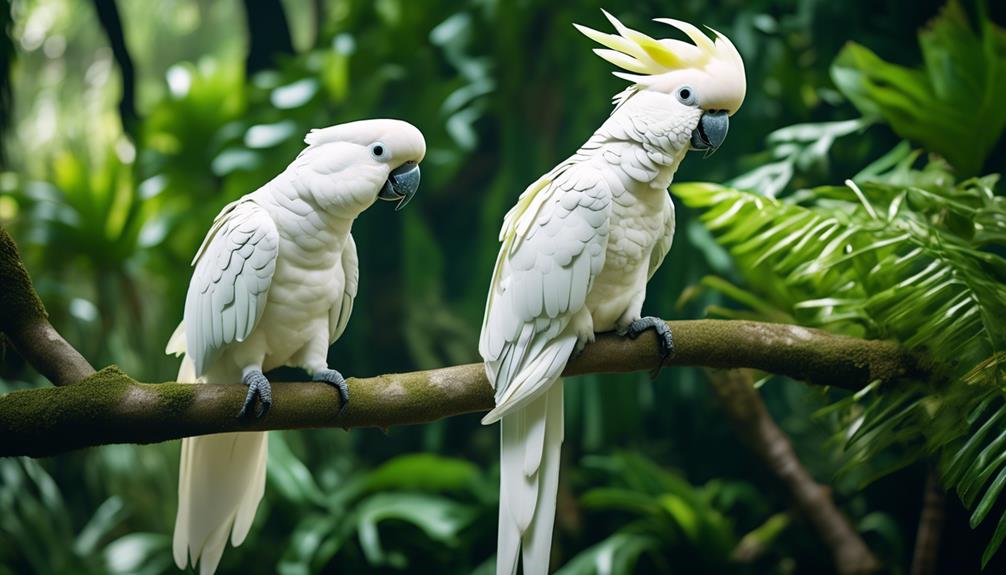
The Phillippine Cockatoo, an endangered bird known for its distinctive crested head, has majority white plumage with pale yellow under-feathers. This great bird stands out with its elegant appearance and unique features. With a length of 12 inches and an 8.5-inch wingspan, the Phillippine Cockatoo is relatively small in size.
Found in the Phillippine islands, this bird prefers lowland tropical rainforests as its habitat. It feeds on seeds, fruits, and nuts, supporting its diverse diet. The plumage of the Phillippine Cockatoo is predominantly white, with hidden red under-tail feathers adding a touch of color. During the breeding season, these birds become even more striking, as they display long feathers called aigrettes. These aigrettes are black and contrast beautifully against their white plumage.
The Phillippine Cockatoo is often seen near freshwater and saltwater areas, where it shares its habitat with other avian species like the American white ibis. When perched, these birds often tuck their necks, giving them a sleek and elegant appearance. Despite their endangered status, the Phillippine Cockatoo continues to captivate with its beauty and grace.
Rock Ptarmigan
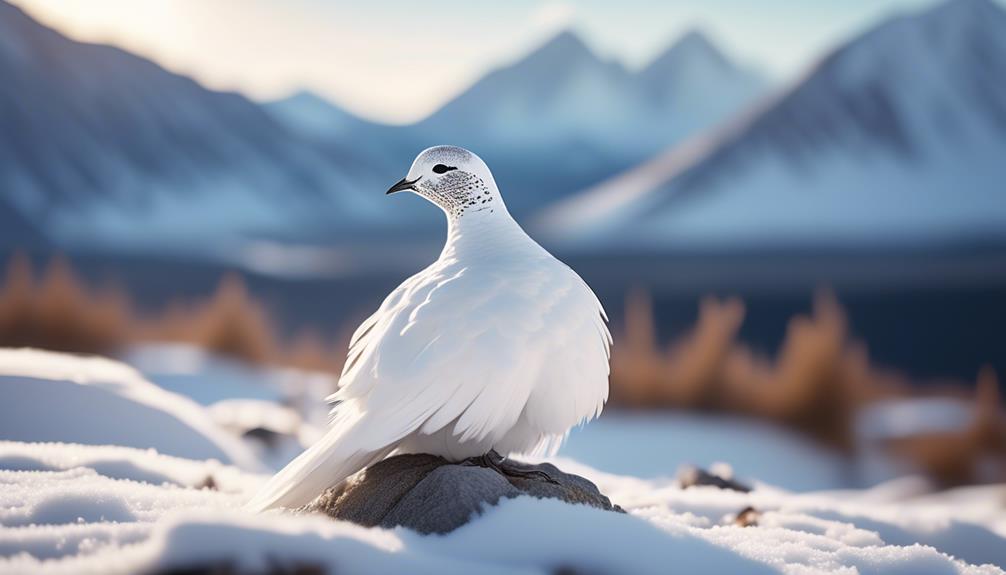
Rock Ptarmigan is a striking bird with predominantly white plumage and faint streaks of gray. This unique coloration allows it to blend seamlessly into its snowy surroundings. As a member of the grouse family, Rock Ptarmigan thrives in cold climates and is commonly found in snowy, mountainous regions. During the winter, its plumage undergoes a notable transformation, turning completely white to provide effective camouflage.
The male Rock Ptarmigan displays an interesting courtship behavior known as the ‘song flight.’ During the breeding season, it flies in circles while calling to attract a mate. This display is a spectacle to behold.
To navigate its snowy habitat, the Rock Ptarmigan has evolved specialized feathers on its feet, acting as snowshoes. This unique adaptation allows it to walk on top of deep snow without sinking.
While the Rock Ptarmigan is a magnificent bird, it isn’t the only member of the avian world with white plumage. Other birds, such as the American white ibis, Snow Goose, snowy egrets, Royal Spoonbill, Mute Swan, Trumpeter Swan, White Before the Shark, Blue Heron, and large egret, also possess striking white feathers. However, the Rock Ptarmigan stands out with its subtle gray streaks, making it a true beauty in the snowy landscapes it calls home.
Snowy Egret
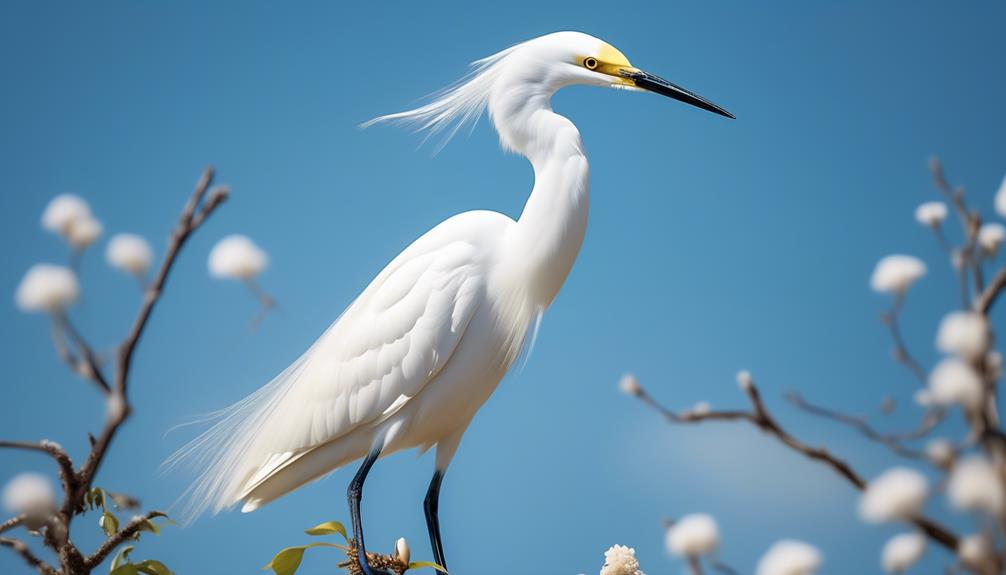
As we shift our focus from the Rock Ptarmigan to the Snowy Egret, prepare to be captivated by the elegant appearance and skillful hunting behavior of this small white bird.
The Snowy Egret, also known as Egretta thula, is a stunning creature found in Europe, Asia, Africa, and the Americas. With its white plumage, black legs, and yellow feet, it stands out amongst its surroundings. Measuring between 22 to 26 inches long with a wingspan of about 39 inches, this lightweight bird weighs between 11 and 13 ounces.
The Snowy Egret is commonly seen near shallow bodies of water such as marshes, lagoons, and mangroves. It’s known for its graceful presence and its ability to skillfully hunt for fish and small invertebrates. Unlike other giant egrets, the Snowy Egret is smaller in size, yet it exhibits an impressive hunting behavior. With patience and precision, it stalks its prey, slowly moving through the water, and then strikes with lightning speed to catch its meal.
This white fluffy bird is a sight to behold as it gracefully glides across the water’s surface, its elegant appearance further enhanced by its delicate movements. Whether it’s standing still in a wetland or in flight, the Snowy Egret captivates with its beauty.
Trumpeter Swan
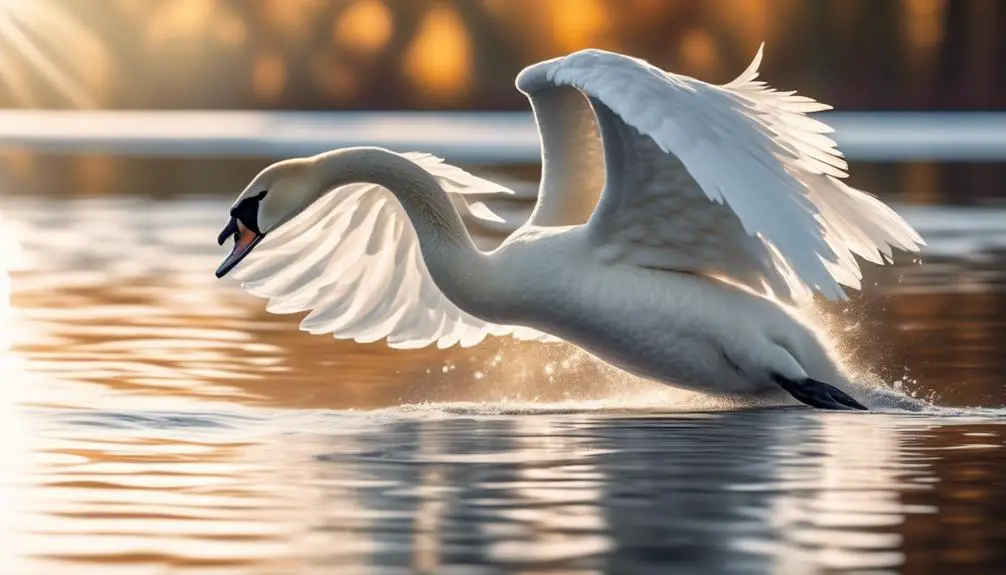
Get ready to be amazed by the majestic Trumpeter Swan, the largest native North American swan with its stunning white plumage. These white fluffy birds are truly a sight to behold. With their long graceful necks and powerful wings, they epitomize elegance and beauty.
One of the most distinctive features of the Trumpeter Swan is its trumpeting call. It’s a sound that can be heard from a distance, especially during their migrations. It’s a call that echoes through the air, capturing the attention of all who hear it.
When it comes to their diet, Trumpeter Swans feed on a variety of aquatic plants, invertebrates, and sometimes even small vertebrates. They’re excellent divers and can stay underwater for several minutes in search of food.
Males of this species are usually larger and heavier than females. With a wingspan that can reach up to 10 feet, they’re truly impressive in size. However, despite their grandeur, Trumpeter Swans were once endangered. Thanks to conservation efforts, their populations have made a successful recovery.
Snow Goose
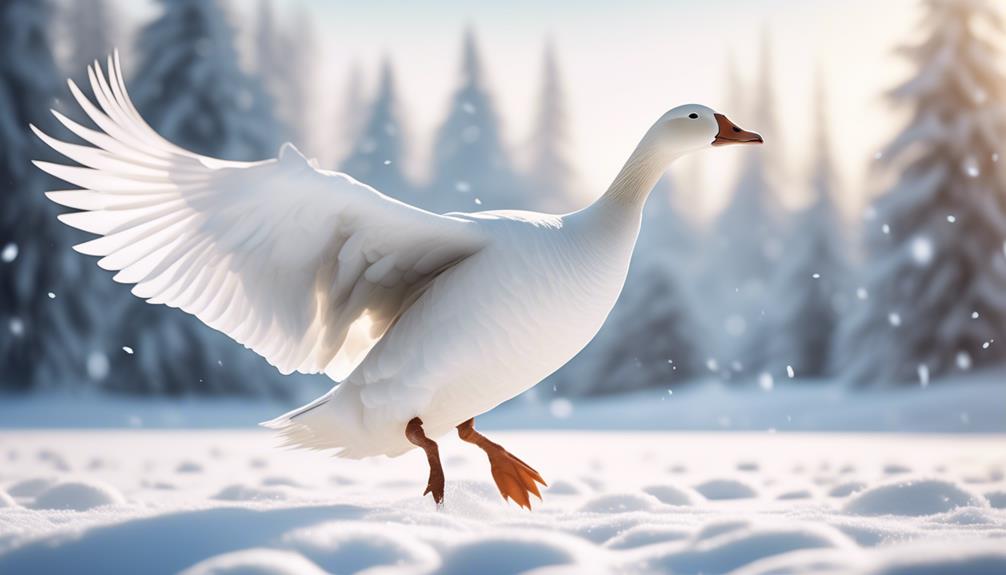
Snow Geese, with their mostly white plumage and black wingtips and tail feathers, are medium-sized birds known for their remarkable migrations. These fluffy birds have a distinct appearance, with their white feathers giving them a pristine and elegant look. The Snow Goose’s beak, or bill, is short and stout, perfectly adapted for their herbivorous diet. Their wings are strong, enabling them to fly long distances during their migrations. As they take flight, their black wingtips create a striking contrast against their white bodies. The Snow Goose’s tail feathers also contribute to their graceful appearance, adding balance and maneuverability in the air. These birds are truly a marvel to behold.
During their migrations, Snow Geese form large flocks, creating a captivating sight as they blanket the sky with their white plumage. The sheer number of these birds is awe-inspiring, and their fluffy feathers make them appear even more enchanting. Snow Geese are known to travel thousands of miles between their breeding and wintering grounds, showcasing their incredible stamina and determination. Their wintering grounds along the Gulf Coast and other southern areas are transformed into a sea of white as these birds gather in large numbers.
Glaucous Gulls
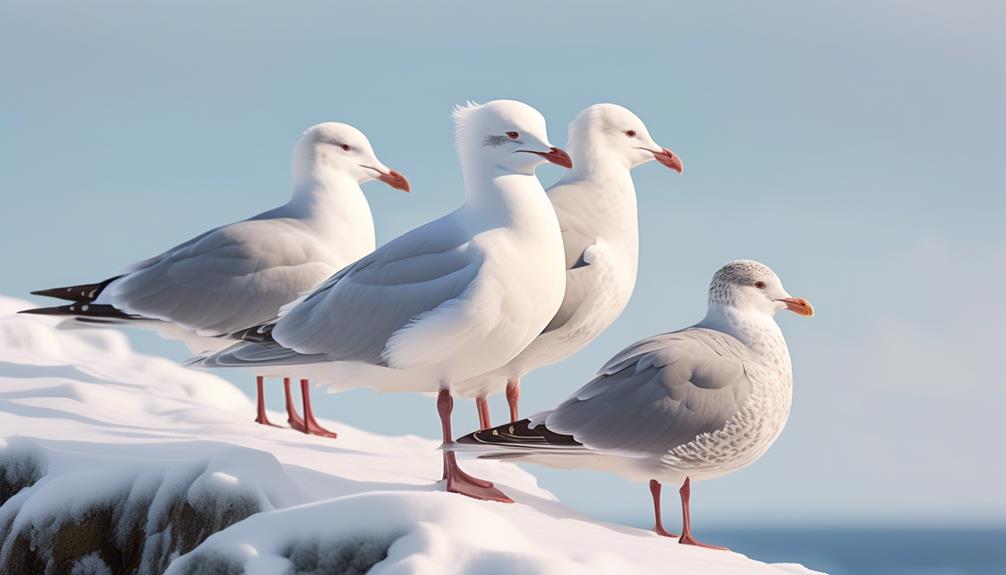
Blanketing the sky with their white plumage, the Snow Geese give way to the next majestic bird species – the Glaucous Gulls. These white fluffy birds are large and robust, with a wingspan of about 55-65 inches and weighing up to 5 pounds. Their distinctive yellow bill and legs make them easily recognizable.
Glaucous Gulls are known for their scavenging behavior, often seen feeding on carrion and stealing food from other birds. They inhabit polar regions such as the Arctic and subarctic zones, nesting on cliffs and rocky outcrops. During the breeding season, Glaucous Gulls have a mottled appearance with a mix of white and gray feathers.
Glaucous Gulls are well-adapted to their harsh environments, with their white plumage providing excellent camouflage against the snow and ice. They’ve strong beaks that enable them to crack open shells and access food sources that other birds may struggle with. These gulls are opportunistic feeders, taking advantage of whatever resources are available in their habitat. Their scavenging behavior plays an important role in maintaining the balance of the ecosystem.
While they may not be as well-known as some other bird species, Glaucous Gulls are a vital part of the polar ecosystem. Their ability to thrive in extreme conditions showcases their resilience and adaptability. So next time you spot a white fluffy bird soaring through the sky, take a closer look. It just might be a magnificent Glaucous Gull.
American White Ibis

The American White Ibis, with its striking white plumage, pinkish-red legs, and distinctive downward-curving long beak, is a captivating sight in its natural wetland habitat. Native to the Americas, this beautiful white bird with a long, black beak can be found in a range of habitats, from Canada to Florida and even South America. Unlike a bird of prey, the American White Ibis doesn’t hunt other animals. Instead, it feeds on small aquatic prey, such as fish, frogs, and insects.
Resembling herons or cranes, this social bird often forms nesting colonies in wetlands, marshes, swamps, small creeks, and shallow pools. The American White Ibis showcases a unique and elegant presence as it gracefully forages and navigates its preferred wetland environments. Its striking appearance, coupled with its sociable behavior, makes it a fascinating bird to observe. Whether it’s wading through the water or flying overhead in its flock, the American White Ibis adds a touch of beauty to any wetland landscape. Its pinkish-red legs provide a sharp contrast against its white plumage, making it easily distinguishable from other birds.
Mute Swan
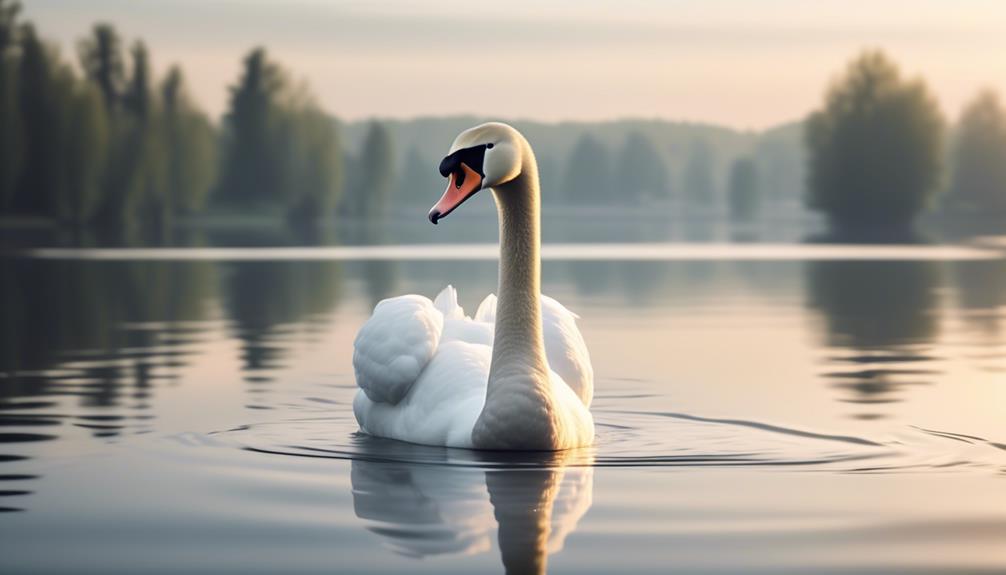
Gliding gracefully on bodies of water, the Mute Swan captivates with its large white form, elegant neck, and fierce protection of its offspring. These white fluffy birds, native to Europe and parts of Asia, have also been introduced to North America. With their pure white plumage and orange bills, Mute Swans are a striking sight as they glide across lakes and ponds. They’re known for their elongated necks, which add to their graceful appearance.
Mute Swans are monogamous and mate for life. They form strong bonds with their partners and display a strong sense of loyalty. During breeding season, they build large nests made of reeds, grass, and other plant materials. The female typically lays around five to eight eggs, which both parents take turns incubating for about 35 to 41 days.
Once the cygnets hatch, the Mute Swan becomes fiercely protective of its offspring. They’ll aggressively defend their young against any perceived threat, even humans who come too close. This protective behavior has earned them the reputation of being one of the most aggressive swan species.
Royal Spoonbill
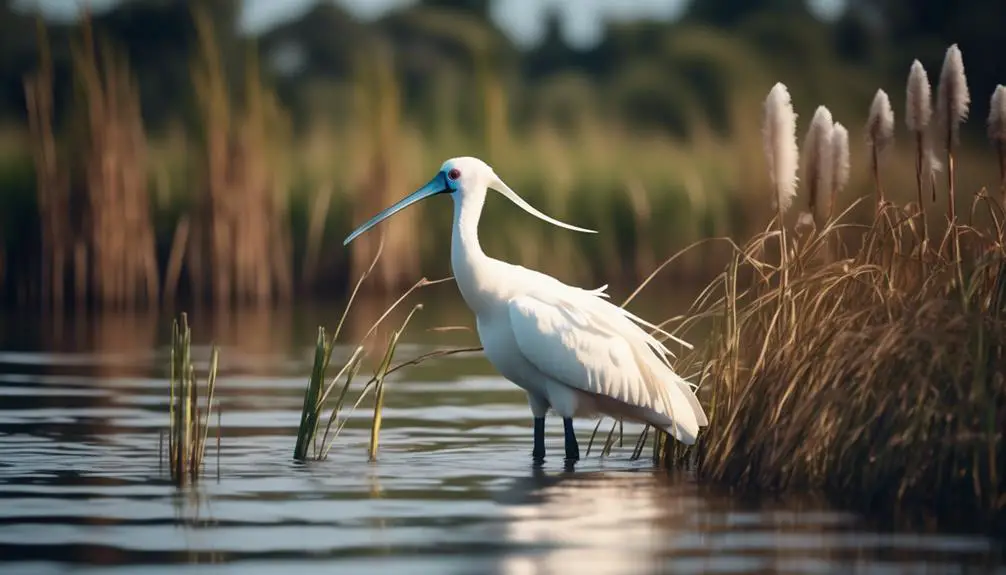
With its distinctive spoon-shaped bill, the Royal Spoonbill is a white, long-legged bird found in freshwater and saltwater wetlands. This elegant bird can be found in the northern mainland of Australia, gracefully wading through wetlands in search of its prey. With a wingspan ranging from 28 to 34 inches, the Royal Spoonbill weighs between 3.1 to 4.6 pounds. It’s easily recognizable by its white plumage and elongated, spoon-shaped bill.
This unique bill isn’t just for show; it serves a purpose in the bird’s hunting technique. Using its bill, the Royal Spoonbill catches crustaceans, fish, and small aquatic prey. These birds are often found in colonies, adding to the beauty of the wetlands they inhabit.

Erzsebet Frey (Eli Frey) is an ecologist and online entrepreneur with a Master of Science in Ecology from the University of Belgrade. Originally from Serbia, she has lived in Sri Lanka since 2017. Eli has worked internationally in countries like Oman, Brazil, Germany, and Sri Lanka. In 2018, she expanded into SEO and blogging, completing courses from UC Davis and Edinburgh. Eli has founded multiple websites focused on biology, ecology, environmental science, sustainable and simple living, and outdoor activities. She enjoys creating nature and simple living videos on YouTube and participates in speleology, diving, and hiking.

